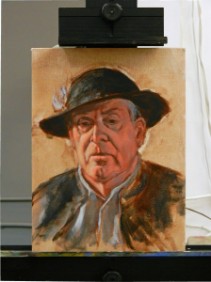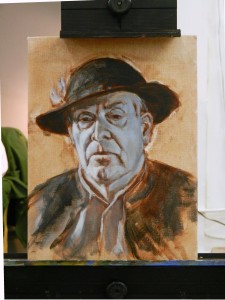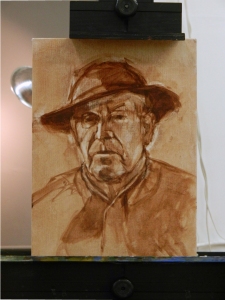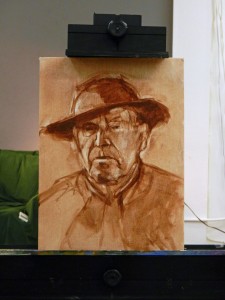I made something today.
I prepared an inexpensive canvas board with acrylic burnt umber, and in 3 1/2 hours painted a portrait of the esteemed model Burr.
Here it is:

This painting started as a blank space, and now with the alchemy of light and shadow, brush and hand, eye and heart, I have a portrait.
It feels like magic sometimes.
This one is different though. It isn’t my best, certainly not my worst, but I completed it in 3 1/2 hours (give or take a few model breaks).

What makes it different, what kept me enthralled as I held it on the way home was this: I did it in acrylic, I painted four layers of paint using a process that usually takes much more time. (It was also dry almost immediately, imagine that! )
Acrylic is not my native tongue; I speak in the language of oil, I paint and build and create with that most rich and seductive of media.

Yet I also teach, and acrylic is a preferred medium for many students and artists. To not be familiar with it, to not ‘speak’ this common language would be shortsighted and iconoclastic.
So, I play with acrylic from time to time, and have produced some fairly decent gestural figures on paper.
But this painting today… different.
I chose acrylic paint for a reason; to explore ways of teaching my particular ‘indirect’ style within a shorter period of time, a 3-5 day workshop or similar.

I have taught this method, sometimes thought of as the ‘old masters’ painting style, for many years; but only over 8-10 week sessions, plenty of time for new and returning students to learn the process and work on all the layers required, and let them thoroughly dry between sessions. (We mostly work in oils, though there are always acrylic painters in attendance, and I have demonstrated in acrylic from time to time. )

But I have been itching to teach this old masters method as a workshop, and I’m looking at ways to accomplish it. Oil dries too slowly; my choices for a short intensive class will probably be either alkyd oils, acrylic, or possibly oil over acrylic (with the understanding that good students would go home and paint their future works in only oil or only acrylic, I don’t want to be held responsible for wide-spread delamination of paint layers).

So I will produce a few samples, using these different methods, and see what happens. I thought I would work in alkyd oil paints, using them for the first two layers, and finishing with regular oil paint on the top (Delamination not a problem here!) Alkyd paints can be stinky though, with more volatile compounds filling the air.

The acrylic was definitely a fight at the beginning, the first layers just do not blend into the silky smoothness I can achieve with oil. A different grammatical structure, the acrylic language.
But as I moved from the tonal underpainting into the opaque lights, I was able to more competently manipulate the paint as I wanted to, although not as deftly as I am used to.
And the final layer of color over the grisaille? 15 minutes.
Of course, I did not have time to tweak all the places that I normally would; but speeding up my process while grappling with an unfamiliar media was fun, and resulted in a nice, loose portrait.

